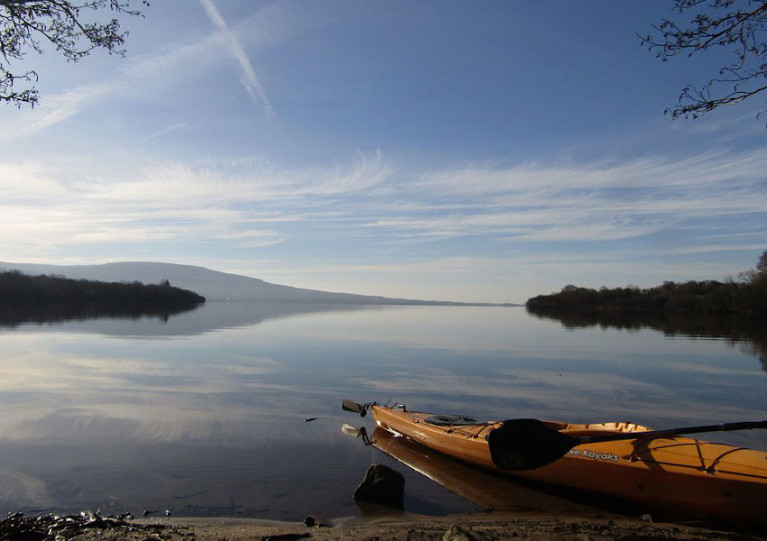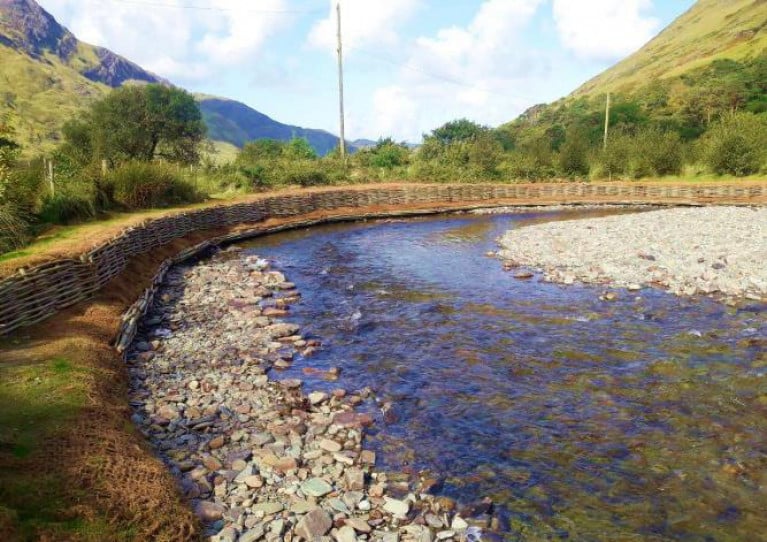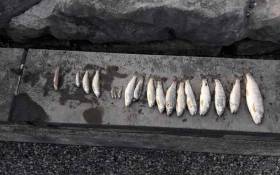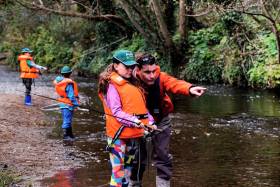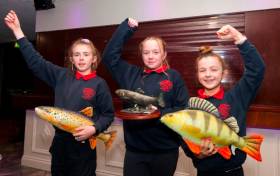Displaying items by tag: Inland Fisheries Ireland
Building on the success of last year’s Tuna CHART (CatcH And Release Tagging) pilot programme, a bluefin tuna research catch-and-release fishery for Ireland will operate in 2020.
A maximum of 25 authorisations may be granted to qualifying angling charter vessel skippers around the Irish coast for this fishery which will open on Wednesday 1 July and close on Thursday 12 November, without exception.
And depending on the successful operation and review of this year’s fishery, it is intended that a scientific catch and release fishery may also operate in 2021 and 2022.
Atlantic bluefin tuna, the largest tuna in the world, frequent Irish coastal waters to feed during its annual migration through North Atlantic waters. The bluefin tuna is prized by sea anglers for its power and fighting ability and is a very valuable commercial species.
The Tuna CHART programme is a collaborative scientific programme between Inland Fisheries Ireland (IFI) and the Marine Institute in partnership with the Sea Fisheries Protection Authority, the Department of Agriculture, Food and the Marine (DAFM) and the Department of Communications, Climate Action and Environment (DCCAE).
In 2019, the Tuna CHART pilot programme authorised 15 charter skippers to operate a scientific fishery, in which anglers participated fully, to catch, tag and release bluefin tuna.
These professional skippers were trained to tag, measure and record bluefin data and over the course of the 2019 three month season, 219 bluefin tuna were caught, tagged and released. As many as eight bluefin were tagged on one fishing trip.
All tuna were carefully handled subject to strict guidelines set by the Tuna CHART programme and all were released alive. Data from the tagging programme are being collated by the partnership for reporting to the International Commission for the Conservation of Atlantic Tuna (ICCAT).
As with the pilot programme, this year’s authorised skippers will be required to have high specification rods, reels and line in advance of the open season in order to bring the fish alongside in a timely manner. Skippers will be required to collect data on every bluefin trip undertaken and each bluefin tuna they catch, tag and release.
A call for applications for the 2020 fishing season will be announced next Tuesday 18 February and the last date for the receipt of a completed application will be 1pm on Friday 6 March.
Shannon Navigation Advisory Over Fisheries Survey Nets On Lough Allen
Waterways Ireland advises all masters of vessels and water users that Inland Fisheries Ireland (IFI) will be placing fisheries survey nets on Lough Allen from today, Tuesday 21 January to this Thursday 23 January.
The nets will be in the waterway during daytime and night-time and will be marked with buoys.
Vessels in this part of the Shannon Navigation should proceed with additional caution during this period.
Inland Fisheries Ireland Launches 2020 Funding Call To Community Groups & Angling Clubs
Inland Fisheries Ireland (IFI) has opened a new funding round available to community groups and angling clubs across the country.
The funding will be awarded to fisheries conservation projects and development projects with over €1.3 million announced yesterday (Thursday 16 January).
Applications are invited from angling clubs, local development associations, tidy towns and others who may be looking to carry out relevant projects.
The 2020 funding call consists of three schemes:
- The Capital Grants Scheme 2020 (€240,000): This scheme supports projects which will help deliver an accessible and sustainable fisheries resource for all. It is aimed specifically at capital projects which will improve angling access and infrastructure (eg accessible fishing stands, walkways, etc).
- The Midlands Fisheries Fund (€50,000): This scheme focuses on sustainable development works in the Midlands Fisheries Group permit area. The fund has been created through contributions from permit income received. Projects which will be eligible to receive support will improve fish habitats in a sustainable manner (eg river bank protection, control of exotic species, etc).
- The Salmon and Sea Trout Rehabilitation, Conservation and Protection Fund (€1 million): The aim of this fund is to rehabilitate, protect and conserve salmon and sea trout and their habitats. This year, funding will be available for conservation projects only (eg fish passage improvement, spawning enhancement, etc).
IFI’s Suzanne Campion said: “We are committed to realising the potential of the fisheries resource from a social and economic perspective but also to protecting it for future generations to enjoy.
“Interested groups are invited to get in touch with us for further information with guidance available throughout the application process.”
For more information about the 2020 Funding Call, download the information booklet. To submit an expression of interest, visit the IFI website HERE.
All applicants must apply through an ‘Expression of Interest’ form to progress to full application. Full applications may be submitted until the closing date of Tuesday 25 February.
82 Rivers To Open For Salmon Angling This Wednesday
A total of 82 rivers will open for salmon and sea trout angling in the 2020 season that commences this Wednesday 1 January.
“This will allow everyone to share in this important natural resource, for which conservation will be to the fore,” said Sean Canney, Minster of State with responsibility for inland fisheries, who added that “41 of the rivers will be fully open with a further 41 available on a ‘catch and release’ basis”.
Legislation governing the coming year’s wild salmon and sea trout fisheries was informed by management advice from Inland Fisheries Ireland (IFI) on more than 140 distinct salmon stocks, and related scientific assessments carried out by the independent Technical Expert Group on Salmon (TEGOS).
The same advice was also made available as part of a statutory public consultation process during which 27 written submissions from stakeholders were received.
Along with the 82 openings, it was recommended that 65 rivers be closed for 2020 as they have no surplus of fish available for harvest.
Minister Canney said: “Ireland is internationally recognised for elevating the conservation imperative to the pinnacle of our salmon management principles and, as the International Year of the Salmon draws to a close, I am proud to have led Ireland’s participation to this global initiative.
“Environmental change and human impacts continue to place salmon and other species at risk. I am determined that the innovations of International Year of the Salmon which brought people together to share knowledge and raise awareness will endure. This is key to ensuring the resilience of salmon in Ireland and in the entire Northern Hemisphere.”
Salmon & Sea Trout Angling Licences For 2020 Are Now Available Online
Licences for salmon and sea trout angling for the 2020 season can now be purchased online along with log books and gill tags, Inland Fisheries Ireland (IFI) has announced.
Licence fees remain the same across all classes including those for juvenile anglers. An annual licence covering all districts costs €100 (€10 for juveniles under 18 years), while licences for single districts are €56 for the year, €40 for 21 days and €20 for a single day. Licences for the Foyle Area Extension are €80.
Anglers are legally required to be in possession of a licence when fishing for salmon or sea trout.
Licences should be purchased online by next Wednesday 18 of December to allow time for delivery before Christmas and the New Year. IFI cannot guarantee dispatch in advance of the holidays due to postage deadlines.
Online licences can also be acquired directly from your local IFI office or approved online licence sales distributors.
Angling licences other than online sales will be available to purchase in approved licence sales distributors from the end of December or early January.
IFI also reminds all salmon and sea trout anglers to return their 2019 angling logbook and unused gill tags as soon as possible, even if there is no catch recorded.
These returns will provide vital information regarding the status and management of our wild Atlantic salmon and sea trout stocks for the future.
Anglers are asked to use the business return envelope which was supplied at the time of license purchase. In the absence of the prepaid return envelope, anglers can return their completed logbook and unused tags to the IFI office address on their licence/logbook.
Significant Increase in Number of Fish Kills in 2018 with More Predicted in Years to Come
Inland Fisheries Ireland has noted with concern the latest findings from the Water Quality in Ireland Report for the period 2013-2018, published today by the EPA. The report shows a decline in river quality and a further loss of pristine river water bodies. It also highlights that the number of fish kills increased to 40 in 2018 after a historic low of 14 in 2017.
Commenting on the report, Dr Ciaran Byrne, CEO of Inland Fisheries Ireland said: “The decline in water quality and in particular in river quality since 2015 shows an increase in pressures coming from human activities. These activities such as agriculture, wastewater issues, forestry and hydromorphology (man-made changes to the physical form of the river) are all putting pressure on the aquatic environment, which in turn can have long term impacts on our fisheries resource.
It is extremely disappointing that the percentage of high-quality biological river sites with undisturbed natural conditions has decreased from 31.6% in 1987-1990 to 17.2% of sites in 2016-2018. These high-quality sites are important for supporting sensitive fish species such as juvenile salmon and trout so any decline in this regard is worrying. Fortunately, the picture for lakes is more stable with a small number showing improvement since the last assessment.”
The EPA report also gives details of fish kills which occurred during 2018, as supplied by Inland Fisheries Ireland. While there was a significant increase in fish mortalities last year, it is likely that the hot weather and low flow conditions experienced in the summer of 2018 may have caused fish to be more vulnerable to pollution events. Of the 40 fish kills in 2018, 15 were caused by disease or natural causes, seven by agricultural practice, eight by municipal works, two by industrial operations and a further eight fish kills had unknown causes.
Dr Byrne continued: “During periods of low water levels and warm water temperatures, there are additional pressures on Ireland’s watercourses as a result of reduced oxygen in the water. Any poor quality discharges to rivers and lakes, such as silage effluent or sewage discharges can put extra demands on the oxygen levels, resulting in pollution incidents and fish kills.
In the context of climate change, we anticipate that the number of fish kills will continue to increase. This issue is even more critical when we consider that rivers with poor water quality do not have the resilience to deal with pollution events during periods of stress. Radical change is needed if we are to ensure the sustainability of our valuable fisheries resource into the future.”
Inland Fisheries Ireland Seeks Views In Survey On Angling Participation
Keen to encourage more people of all ages to discover and enjoy angling as a sport and pastime, Inland Fisheries Ireland (IFI) is looking to gather the views of the public around fishing via an online survey.
IFI says its findings will help inform a Novice Angler Strategy which will aim to increase participation across all types of angling.
The survey looks to discover the barriers novice anglers could experience when it comes to fishing, and to find out their perceptions and experiences of fishing to date.
It also will survey existing anglers around the type of fishing they practice and examine how angling clubs recruit and interact with novice anglers.
“We know that there are fewer people fishing than there were in previous decades and we want to find out why and how we can interest them in this lifelong hobby,” says Suszanne Campion, IFI’s head of business development.
“Fishing is a sport which is suitable for all ages and abilities. In today’s society, outdoor recreational activities are more important than ever from a health and well-being perspective, and in Ireland we are uniquely placed with the breadth and quality of our fisheries resource which is available to all to enjoy.
“The information and views of the public are very important to us and will help to make angling better for everyone.”
The online questionnaire takes only around 15 minutes to complete, and all who take part will be in with a chance of winning one of three €50 vouchers for fishing equipment.
Inland Fisheries Ireland (IFI) has recently commenced a comprehensive sea trout assessment and monitoring programme in the Lough Currane catchment in Kerry.
The project, called Currane STAMP, aims to identify potential factors contributing to the apparent decline of sea trout populations in the area in recent years.
It follows reports from anglers of reduced catches and is funded by IFI through its Salmon and Sea Trout Rehabilitation, Conservation and Protection Fund.
Sean Canney, Minister of State with responsibility for inland fisheries, said: “The Currane system is an internationally renowned angling hotspot for salmon and sea trout and hosts some of the longest lived and largest sea trout found in Ireland.
“However, recent indications from angler rod catch reports suggest declines in sea trout populations in the system and I support Inland Fisheries Ireland’s attempts to get to the bottom of these developments.”
The Currane project is one of 25 across 16 counties which have been awarded funding by IFI through its National Strategy for Angling Development.
The organisation today (Thursday 5 December) announced funding of €1 million for fisheries conservation, protection and education initiatives and for projects which will give the public greater access to fishing sites around the country.
In total, €242,900 has been awarded to the research project on the Currane — €55,800 in 2018 and a further €187,000 in this latest funding call.
A separate initiative at Scartleigh Weir near Listowel will also receive €6,000 to support the provision of CCTV equipment to monitor illegal poaching activity in the area.
As part of the programme on the Currane, researchers will use a combination of traditional and novel research techniques to examine important aspects of sea trout ecology throughout their life stages.
‘This project will help to answer key questions related to the apparent decline of trout in the area’
Habitat surveys will map important spawning and nursery areas while electrofishing (a benign technique used to catch fish by stunning them for a short period of time) will be conducted to assess juvenile fish population trends against previous studies in the area.
IFI researchers have already begun tracking the movement of juvenile sea trout tagged with tiny acoustic tags. Acoustic receivers, which record the movement of any tagged sea trout passing within range, have been strategically placed in freshwater in the Currane system and in the sea in Ballinskelligs Bay with a view to uncovering the freshwater movement and inshore migratory routes of sea trout and determining their survival in the marine environment.
The research will be co-ordinated and conducted from Met Éireann’s Valentia Observatory in Cahersiveen where IFI research officer Ryan Murray will be based and supported by experienced local fisheries staff.
In addition to the sea trout assessment, the team will also work on a salmon monitoring programme which will aim to determine if population trends between the two species are related or independent.
IFI’s head of R&D Dr Cathal Gallagher said: “This research will collect vital information on sea trout which will ultimately inform management strategies which may be required to combat the possible deterioration of sea trout in the Currane system. I would like to acknowledge the support of Met Éireann for this project and we look forward to working with local anglers on the ground to help establish the status of sea trout populations.”
As part of a citizen science initiative within the programme, IFI will be enlisting the invaluable knowledge and assistance of local anglers to establish current and historical rod catch trends.
Neil O’Shea, a fourth generation Currane ghillie who is supporting the programme, said: “I am looking forward to contributing to the sea trout citizen science component developed by Inland Fisheries Ireland. This project will be important for the sea trout fishery in Currane and will help to answer key questions related to the apparent decline of trout in the area.”
Shepperton Lakes in West Cork will now be eco-friendly following the introduction of measures to reduce the carbon footprint of anglers fishing the popular Shepperton (Shreelane) fishery.
Inland Fisheries Ireland (IFI) is introducing regulations which will only permit battery-powered engines on the lake from 1 January 2020.
As part of the eco-friendly measures, Inland Fisheries Ireland is removing its four petrol engines from use at Shepperton, between Leap and Skibbereen.
Anglers can now hire one of the recently refurbished boats and bring their own battery-powered engines.
This follows similar measures introduced at Ballinlough, north of Leap, which has operated successfully for a number of years.
The boat hire at Shepperton Lakes, including a one-day fishing permit for up to two anglers, will cost €30.
‘…a popular winter pike angling destination attracting local and visiting anglers to the area’
Sean Long, director of the South Western River Basin District, said: “This initiative was proposed by the local Inland Fisheries Ireland ‘Green Team’ as a quick and simple measure to reduce carbon emissions.
“We are pleased to offer this green solution to anglers at the lake while also maintaining the permit price once again this year.”
IFI’s Green Team comprises staff in various locations across the country and is part of the organisation’s efforts to refocus its philosophy in line with the critical nature of climate change and the impact it is having on the fisheries resource.
The Green Team works to create solutions which will help achieve an energy reduction target of 33% by 2020 and devise solutions which will support society in reducing its environmental footprint.
Shepperton/Shreelane Lakes in West Cork represent a popular winter pike angling destination attracting local and visiting anglers to the area.
As shore angling is not permitted, anglers are advised to book a boat locally from Mrs E Connolly via telephone 028 33328 in advance to avoid disappointment.
Doora National School from Ennis, Co Clare has been named winner of Inland Fisheries Ireland’s (IFI) national Something Fishy contest for 2019.
The students from sixth class were presented with the Something Fishy perpetual trophy by Pat Breen TD, Minister of State for Trade, Employment, Business, EU Digital Single Market and Data Protection, at Treacys West County Hotel in Ennis yesterday (Monday 25 November).
Doora National School received the national accolade after being commended for their Something Fishy blog project, which saw them complete artwork on the life cycle of a salmon, report on a field trip they took with local fisheries officers and produce an exercise book.
The blog was accessible to their peers and members of the public on Somethingfishy.ie with a view to sharing their learning experiences and to increasing awareness of their fisheries resource in the local community.
It followed months of engagement by the students in the education programme which saw them work with IFI’s Fisheries Officers from the Shannon River Basin District to learn about their local fisheries resource.
The winners were chosen to go forward to represent their region by Clare Education Centre in June.
During the 2018-2019 academic year, 104 national schools and 12 education centres took part in the fisheries education programme which reached over 2,000 students across the country.
As part of Something Fishy, students learn about fish and the environment, enjoying classroom based activities as well as a practical field trip with fisheries officers. The Something Fishy programme is an initiative of IFI in partnership with Blackrock Education Centre.
Speaking about the Something Fishy award, Minister Pat Breen said it “is particularly special as we celebrate the International Year of the Salmon in 2019, an initiative which hopes to raise awareness around the different challenges that face the Salmon species today”.
‘The level of creativity, passion for learning and enthusiasm shown in their project stood out’
IFI chief executive Dr Ciaran Byrne said: “The students and teachers of Doora National School submitted an impressive project for assessment. The level of creativity, passion for learning and enthusiasm shown in their project stood out and deserves recognition at this national level.
“We would like to thank Clare Education Centre and our partners in Blackrock Education Centre for their support in bringing the programme to the high standard that it is today.”
Ross Darmody, teacher of the winning class in Doora National School, said: “We are proud of the students here at Doora National School for their inspiring enthusiasm to engage with and learn about the fisheries environment and its species.
“The programme is cross-curricular and draws together geography, science and ICT as well as ensuring that the learning is fun for everyone through the interactive online ‘Something Fishy’ resources.
“As a school we look forward to working with Inland Fisheries Ireland again in the future to bring this programme to even more students.”





























